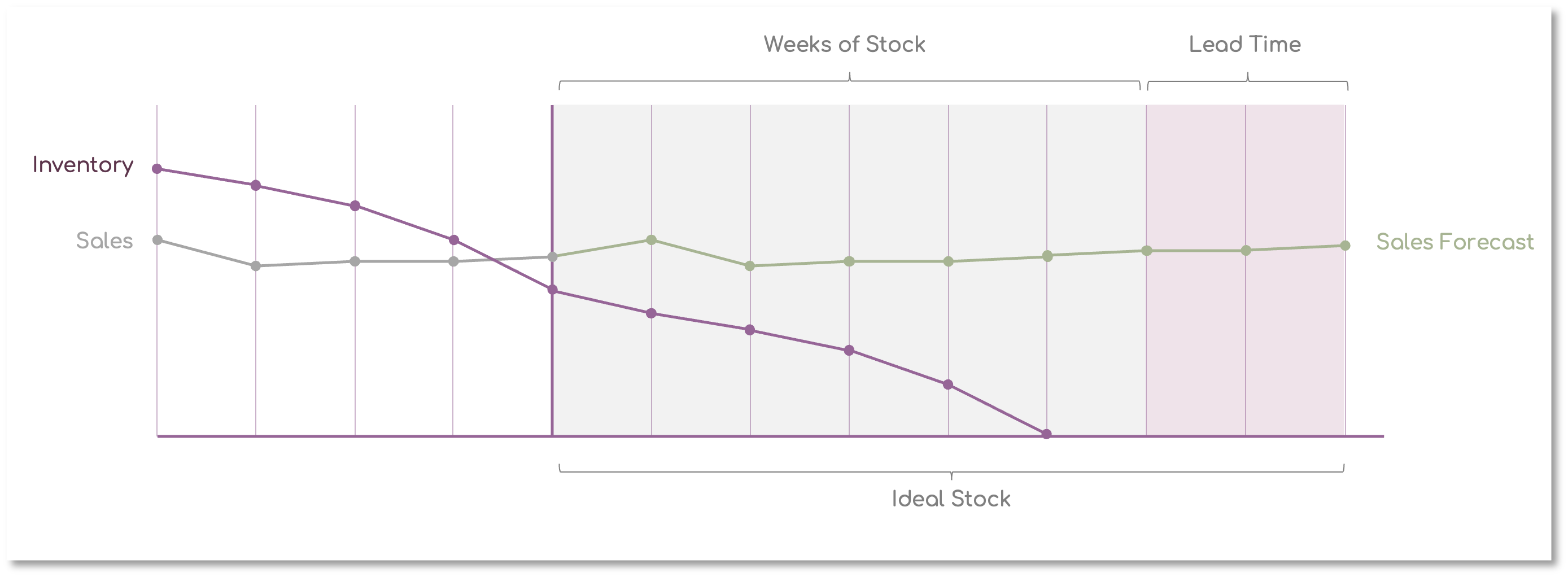Ideal Stock
Ideal Stock
The Ideal Stock is one of the key metrics used in this extension. It represents the stock you should have at your disposal to meet your customer demand. It is sometimes also referred to as Model Stock.
Simplified, the Ideal Stock takes into account these two parameters:
- Customer Demand Variation (for example, your actual demand exceeds your original sales forecast)
- Supplier Delivery Variation (for example, supply deliveries are later than originally planned lead times)

As illustrated in the image above, the Ideal Stock is determined by the Weeks of Stock and the Lead Time for the product. Both of these parameters are set in weeks.
For example, if you want to keep 6 weeks of cover, and your supplier has 2 weeks of lead time for the product, the ideal stock is calculated by summing the forecast (your customer demand) for the next 8 weeks.
Our forecasting engine is set up to find the ideal stock value for your products, based on your customer demand and any external factors. However, for some products, an accurate sales forecast is hard to be calculated. Luckily, the Shelf Planner engine figures out the behaviour of your products and recommends when to use the Ideal Stock, or when for example to order using other parameters.
Minimum vs Ideal Stock
When setting parameters for replenishment in retail, 'Weeks of Stock' and 'minimum stock' serve different purposes and are suitable for different scenarios. Here's a detailed comparison of when to use each:
When to use Ideal Stock
Ideal Stock is calculated using your Sales Forecast, your current and future stock and a number of parameters. In particular the Weeks of Stock parameters is the main driver. Weeks of Stock (sometimes referred to as Weeks of Cover) is a measure that indicates how many weeks the current inventory will last based on the forecasted demand.
1. Demand Fluctuation
When demand is highly variable or seasonal, 'Weeks of Stock' helps adjust inventory levels dynamically according to expected changes in sales patterns.
2. Fast-moving items
For items with high turnover rates, using 'Weeks of Stock' ensures that inventory levels are closely aligned with sales, minimising both stock-outs and excess inventory.
3. Forecast Accuracy
When you have a reliable sales forecast, 'Weeks of Stock' allows you to keep inventory levels appropriate for the expected demand.
4. Short Lead-times
If the lead time from suppliers is short and consistent, 'Weeks of Stock' can be effective because it allows for frequent adjustments to inventory levels based on recent sales data.
When to use Minimum Stock
Minimum stock, also known as safety stock or buffer stock, is the lowest quantity of inventory that you aim to have on hand to avoid stockouts during normal demand fluctuations and lead time variability.
1. Demand Stability
For items with stable and predictable demand, minimum stock levels can be set based on historical sales data and lead times to ensure sufficient inventory.
2. Critical Items
For critical items that must not run out of stock under any circumstances, setting a minimum stock level ensures there is always a buffer to meet unexpected demand or supply delays.
3. Less Frequent Replenishment
For items that are replenished less frequently, minimum stock helps ensure that you have enough inventory between replenishment cycles.
4. Long Lead-times
When lead times from suppliers are long or uncertain, maintaining a minimum stock ensures that you have enough inventory to cover the replenishment period.
